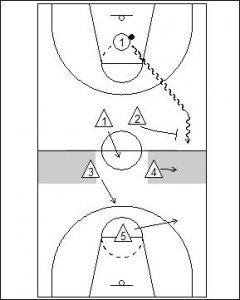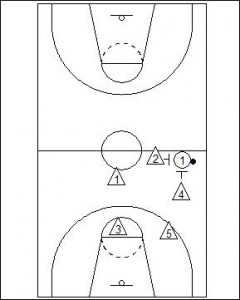2-2-1 Quarter Court Trap
2-2-1 Quarter Court Trap offers something a little different for coaches to utilise within their defensive options. The 2-2-1 Quarter Court Trap provides an option that is that little bit different to full court and half court options often seen for trapping. The 2-2-1 Quarter Court Trap also provides a slightly different formation to what many standard trapping formations utilise like the 1-2-2 or 1-2-1-1.
The quarter court trapping option provides a different look to the defensive set that some offensive teams might not be able to adapt to. Many offensive teams when looking to prepare for trapping situations run scenarios which are predominantly full court or half court. Very rarely will teams conduct trapping preparations for three quarter court. This gives a clear advantage to teams using this variation as it puts teams into the situation they might not have seen, and therefore must adapt to on the run. Trapping at the best of times for offensive teams is a hard enough challenge, without not seeing something prior to a game and then being expected to perform against during a game in a pressure situation.
Another problem area this defence causes for offences is that because the defence is set up in the quarter court then the space to pass through the defence is also reduce for the offense. As soon as the defence is able to start reducing the space that they must cover, they start to also reduce the possible passing options and receiving spots for offense player to choose from. The density of the defenders also provides a more challenging set-up for the offense as there are four defenders in the first two lines of the press instead of the usual three in 1-2-2 and 1-2-1-1 formations.
Be sure though the defender at the back of the 2-2-1 Quarter Court Trap is highly active and capable enough to move from one side of the floor to the other in quick time.
As with all trapping defences the most important part of the defence is not usually the initial trap, but the rotation of players off the ball once the trap happens. Very often the trap is executed only to have an easy pressure release pass made and the offense to be attacking the hoop in an advantage situation. Off the ball defenders must move into passing lanes and reduce the opportunity for these passes.
Like with all traps the 2-2-1 Quarter Court Trap is as much about reading the game by each defender as much as the technique in playing solid defence. Allow your players initially a lot of practice time in game situations so the group can learn what to look for and where to be.

One (1) and Two (2) establish a defensive stance halfway between the three-point line and halfway.
Three (3) and Four (4) establish a defensive position just over halfway ready to assist in the trap if the ball comes to their side of the floor.
Five (5) assumes a position in the key looking to assist by moving into passing lanes created at the back of the trap designed to release pressure for the offensive team.
One (1) and Two (2) must deny the dribbler access to the middle of the floor. The offensive player (1) must be forced down the sideline and channelled.
Grey areas indicate where the trap is best executed.
As the ball moves into the halfway of the court all players should be in motion moving into passing lanes and keeping pressure release passes to a minimum.

As the strong side defenders trap the ball (2 and 4) all players must maintain vision of any offensive players who move into their areas off the ball.
If an offensive players moves through this areas the defenders (1, 3 and 4) must be ready to move and deny a pass.
The player who rotates into the position of defending the keyway must be aware of offensive players on the weak side of the floor and possible lobs to the basket.







